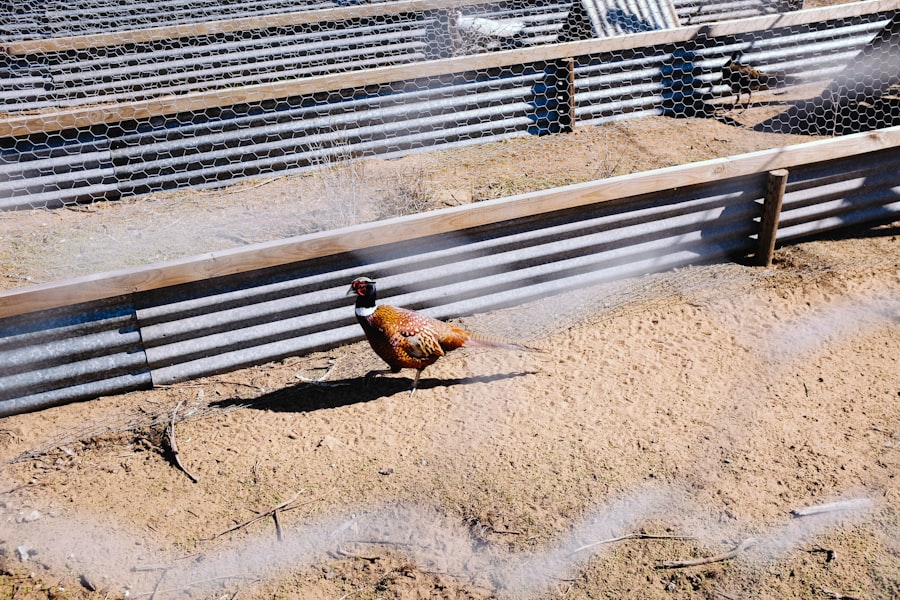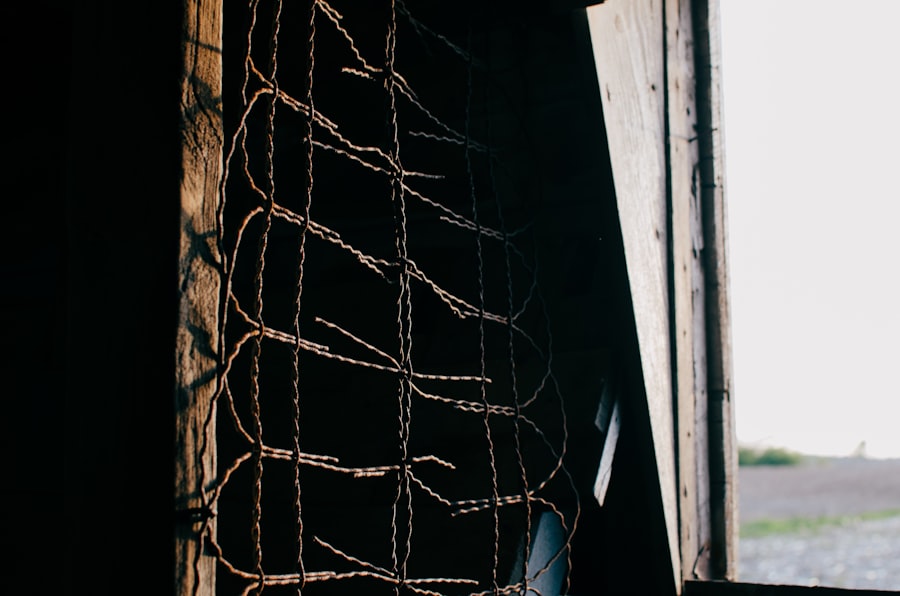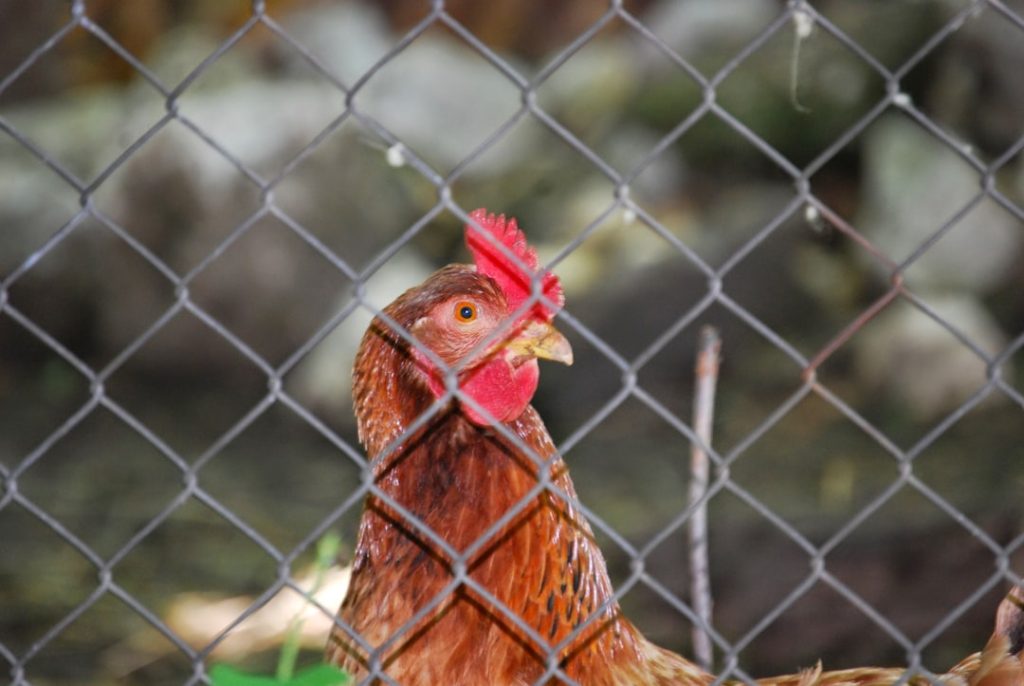Proper fence height is essential for containing chickens within a designated area. Chickens can fly short distances and jump to considerable heights, making it necessary to have an adequately tall fence to prevent escapes. Without proper containment, chickens may cause damage to neighboring properties, leading to potential conflicts.
Escaped chickens are also at risk of predation and other hazards. A sufficiently tall fence serves multiple purposes beyond containment. It helps maintain a clean and organized environment by preventing chickens from accessing and damaging gardens, flower beds, and other landscaping features.
This protection is crucial due to chickens’ natural scratching and pecking behaviors. Investing in a fence of appropriate height ensures that chickens remain safe and secure within their designated space. It allows them to roam and forage in a controlled environment while protecting both the chickens and surrounding property.
Proper fencing is a key component in responsible chicken keeping, balancing the birds’ needs with property management and neighborly considerations.
Table of Contents
- 1 Factors to Consider When Determining Fence Height for Chickens
- 2 Recommended Fence Heights for Different Breeds of Chickens
- 3 Benefits of Using Electric Fencing to Keep Chickens In
- 4 Common Mistakes to Avoid When Choosing Fence Height for Chickens
- 5 Tips for Maintaining and Monitoring Fence Height for Chickens
- 6 Legal Considerations for Fence Height When Keeping Chickens in Residential Areas
- 7 FAQs
- 7.1 What is the recommended fence height to keep chickens in?
- 7.2 Why is it important to have a tall fence for chickens?
- 7.3 What type of fencing is best for keeping chickens in?
- 7.4 Are there any other measures to consider in addition to fence height?
- 7.5 Can I use electric fencing to keep chickens in?
Key Takeaways
- Proper fence height is crucial for keeping chickens in and predators out
- Factors to consider when determining fence height include chicken breed, predator type, and available space
- Recommended fence heights vary for different chicken breeds, with larger breeds needing taller fences
- Using electric fencing can provide added security and protection for keeping chickens in
- Common mistakes to avoid when choosing fence height include underestimating predator capabilities and not considering future growth of chickens
Factors to Consider When Determining Fence Height for Chickens
Chicken Breed and Age
The breed of chickens being contained is a crucial factor, as different breeds have varying levels of flight ability. Some breeds are more prone to flying over fences than others. Additionally, the age of the chickens should be considered, as younger chickens may be more agile and prone to escaping than older ones.
Coop Size and Property Layout
The size of the chicken coop or designated area should also be taken into account, as this will help determine the overall size and scope of the fence needed. Furthermore, the terrain and layout of the property should be considered when determining fence height. For example, if the property is located on a slope or uneven terrain, it may be necessary to adjust the height of the fence to ensure that it is secure and effective.
Predator Protection and Local Regulations
The presence of predators in the area is another important factor to consider. If there are known predators such as foxes, raccoons, or birds of prey in the vicinity, it is essential to have a fence that is tall enough to deter these threats. Finally, local regulations and zoning laws should be taken into consideration when determining fence height, as there may be specific requirements or restrictions that need to be adhered to.
Recommended Fence Heights for Different Breeds of Chickens

The recommended fence height for different breeds of chickens can vary based on their flight ability and size. For larger and heavier breeds such as Orpingtons or Brahmas, a fence height of at least 6 feet is recommended to prevent them from flying over. These breeds are generally not as agile or prone to flying as lighter breeds, so a taller fence is necessary to contain them effectively.
On the other hand, lighter and more agile breeds such as Leghorns or Easter Eggers may require a taller fence of 7-8 feet to prevent them from escaping. These breeds are known for their ability to fly higher and farther distances, so a taller fence is necessary to keep them contained. For bantam breeds such as Silkies or Seramas, a fence height of 4-5 feet may be sufficient due to their smaller size and limited flight ability.
However, it is important to consider individual variations within each breed, as some chickens may be more prone to flying than others. Additionally, it is important to monitor the behavior of the chickens and make adjustments to the fence height as needed. Overall, the recommended fence height for different breeds of chickens should take into account their flight ability, size, and individual variations within the breed.
Benefits of Using Electric Fencing to Keep Chickens In
Electric fencing can be an effective and efficient way to keep chickens contained within a designated area. One of the main benefits of using electric fencing is its ability to provide a strong deterrent against predators. The electric shock delivered by the fence can deter predators such as foxes, raccoons, and birds of prey from attempting to breach the perimeter.
This helps to protect the chickens from potential threats and ensures their safety within the designated area. Additionally, electric fencing is relatively easy to install and maintain, making it a convenient option for chicken owners. Another benefit of using electric fencing is its versatility and adaptability.
Electric fencing can be easily adjusted in terms of height and layout to accommodate different breeds of chickens and varying terrain. This flexibility allows chicken owners to customize the fencing to meet their specific needs and ensure that it is effective in containing the chickens. Furthermore, electric fencing can be a cost-effective option compared to traditional fencing materials, making it an attractive choice for those looking to contain their chickens within a budget.
Overall, electric fencing offers a number of benefits for keeping chickens in, including predator deterrence, ease of installation and maintenance, versatility, and cost-effectiveness.
Common Mistakes to Avoid When Choosing Fence Height for Chickens
When choosing fence height for chickens, there are several common mistakes that should be avoided in order to ensure that the fencing is effective in containing the chickens. One common mistake is underestimating the flight ability of certain breeds of chickens. It is important to research and understand the flight characteristics of the specific breeds being contained in order to determine an appropriate fence height.
Failure to do so can result in chickens escaping over the fence and causing potential damage or harm. Another common mistake is neglecting to consider potential predators in the area when determining fence height. It is essential to take into account the presence of predators such as foxes, raccoons, or birds of prey and ensure that the fence is tall enough to deter these threats.
Failure to do so can leave the chickens vulnerable to attacks and compromise their safety within the designated area. Additionally, overlooking local regulations and zoning laws regarding fence height can lead to legal issues and potential fines. It is important to research and adhere to any specific requirements or restrictions related to fence height in order to avoid legal complications.
Tips for Maintaining and Monitoring Fence Height for Chickens

Fence Inspections and Repairs
Regular inspections should be conducted to check for any signs of wear or damage to the fencing materials. Any weak spots or areas of concern should be addressed promptly to prevent potential breaches by the chickens or predators.
Monitoring Chicken Behavior and Adjusting Fence Height
It is essential to monitor the behavior of the chickens and make adjustments to the fence height as needed. This may involve raising or lowering the fence based on the flight ability and behavior of the chickens.
Maintaining the Perimeter and Staying Informed
In addition to regular inspections and adjustments, it is important to keep vegetation around the perimeter of the fence trimmed and maintained. Overgrown vegetation can provide a platform for chickens to jump or fly over the fence, compromising its effectiveness in containing them. By keeping vegetation trimmed back, you can help prevent potential escapes and maintain a secure perimeter for the chickens. Finally, it is important to stay informed about any changes in local regulations or zoning laws related to fence height to ensure compliance and avoid legal issues.
Legal Considerations for Fence Height When Keeping Chickens in Residential Areas
When keeping chickens in residential areas, there are several legal considerations related to fence height that should be taken into account. Many municipalities have specific regulations and zoning laws regarding fence height that must be adhered to when keeping chickens on residential properties. It is important to research and understand these regulations in order to ensure compliance and avoid potential fines or legal complications.
In addition to local regulations, it is important to consider any homeowners’ association (HOA) rules or covenants that may impact fence height requirements. Some HOAs have specific guidelines regarding fencing materials, heights, and aesthetics that must be followed by residents. Failure to comply with these guidelines can result in penalties or disputes with the HOA.
Overall, it is essential to research and understand any legal considerations related to fence height when keeping chickens in residential areas in order to ensure compliance with local regulations and avoid potential legal issues. By staying informed about these considerations and taking proactive steps to adhere to them, chicken owners can maintain a positive relationship with their neighbors and local authorities while providing a safe and secure environment for their chickens.
If you’re looking to keep your chickens safe and secure, you may want to consider the height of your fence. According to a helpful article on Poultry Wizard, the ideal fence height to keep chickens in can depend on the breed and size of your chickens. For more information on chicken coop design and keeping your chickens safe, check out this article on Poultry Wizard.
FAQs
What is the recommended fence height to keep chickens in?
The recommended fence height to keep chickens in is at least 6 feet tall. This height helps to prevent the chickens from flying over the fence and escaping.
Why is it important to have a tall fence for chickens?
Having a tall fence for chickens is important to prevent them from escaping and to protect them from predators. Chickens are known for their ability to fly short distances, so a tall fence is necessary to keep them contained.
What type of fencing is best for keeping chickens in?
For keeping chickens in, it is recommended to use hardware cloth or welded wire fencing with small openings (no larger than 1 inch) to prevent the chickens from squeezing through or getting their heads stuck.
Are there any other measures to consider in addition to fence height?
In addition to fence height, it is important to consider reinforcing the bottom of the fence to prevent predators from digging underneath. Adding a wire apron or burying the fence underground can help to secure the perimeter.
Can I use electric fencing to keep chickens in?
Electric fencing can be an effective option for keeping chickens in, especially if predators are a concern. However, it is important to follow safety guidelines and ensure that the electric fence is installed properly to prevent harm to the chickens.
Meet Walter, the feathered-friend fanatic of Florida! Nestled in the sunshine state, Walter struts through life with his feathered companions, clucking his way to happiness. With a coop that’s fancier than a five-star hotel, he’s the Don Juan of the chicken world. When he’s not teaching his hens to do the cha-cha, you’ll find him in a heated debate with his prized rooster, Sir Clucks-a-Lot. Walter’s poultry passion is no yolk; he’s the sunny-side-up guy you never knew you needed in your flock of friends!







